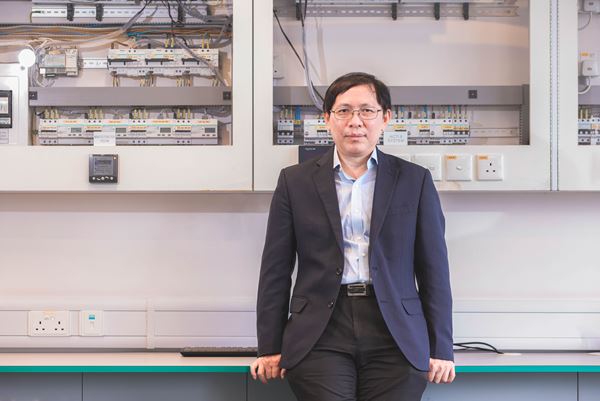Constructing Green Smart Buildings
Professor Wang Shengwei: Precise designs help reduce energy consumption
Global climate change is one of the defining challenges of our time. Governments of more than 127 countries around the world have already set net zero emission targets to strive towards carbon neutrality through energy saving and emission reductions. The Government of the Hong Kong Special Administrative Region has also announced “Hong Kong's Climate Action Plan 2050” which outlines the strategies for achieving carbon neutrality before 2050.
Ranking among the world’s top 100 universities, PolyU spares no effort to help Hong Kong, the Nation and the world combat climate change. It not only conducts forward-looking research to tackle the problem, but also actively applies various solutions, such as smart energy management systems, renewable energy applications and green building materials, to conserve energy and slash emissions in existing buildings on campus and future campus projects under construction or planning. PolyU’s campus sustainability initiatives also provide a good illustrative example for industry and wider society.

According to Professor Wang Shengwei, Director of PolyU’s Research Institute for Smart Energy, Chair Professor of Building Energy and Automation, and Otto Poon Charitable Foundation Professor in Smart Buildings, the research team worked with PolyU’s Campus Development Office to choose the best option from many different energy saving solutions for practical use. “In case there are any problems with the application, the other party will share feedback with us for the next round of improvement.”
When PolyU’s students and staff conduct activities in different offices, meeting rooms and classrooms, it seems natural to have bright lighting and conventional air conditioning. But in reality, the campus buildings come with advanced energy management systems which, while maintaining normal operation, save more than 30% of electricity than ordinary buildings.
“Energy saving can be rather simple,” says Ir Professor Wang Shengwei, Director of PolyU’s Research Institute for Smart Energy, Chair Professor of Building Energy and Automation, and Otto Poon Charitable Foundation Professor in Smart Buildings. “For example, it can be realised by turning up or switching off the air conditioner or purchasing high-efficiency accessories.”
General solutions in the market are usually hardware-driven, incorporating high-efficiency, energy-saving hardware devices. However, the energy saving system developed by Professor Wang leverages cutting-edge technologies such as artificial intelligence and big data analytics to integrate different components of the system for overall analysis. This brings about the most energy-efficient and optimal “coordinative design” from a huge number of solutions, reducing energy consumption to the greatest extent while sustaining normal air-conditioning and lighting.
Since he joined PolyU in 1993, Professor Wang has been dedicated to the research and development of energy management systems. However, environmental protection and energy saving were not the main focus at that time due to the rapid economic growth in Hong Kong. “Somebody in the industry told me that my solution was really good, but not needed,” Professor Wang recalls. Despite such sarcastic comments, his enthusiasm has never waned. Instead, he continued to enhance his solution, and the technology has grown in sophistication over the years. The mood has changed nowadays – global energy prices are surging and “carbon neutrality” has become a key target of every government.
Ten years ago, Professor Wang participated in a power optimisation project for Hong Kong’s International Commerce Centre (ICC), making suggestions on the optimisation of the energy system before the construction work was completed. Today, the building is able to save 18% of electricity, which amounts to 10 million kWh, on an annual basis. As a result, the ICC has saved the significant amount of HK$10 million in electricity bills every year.
“Power optimisation not only saves cost, but also boosts the business image of the International Commerce Centre,” says Professor Wang, who explains the benefits that his energy saving solution brings to the property developer. “As the tenants in the Centre are all investment banks and international corporations who put a strategic focus on corporate governance, the building has to be eco-friendly and energy-efficient so as to attract high value-added brands and multinational enterprises to move in.”
Energy saving solutions not only contribute to industry, but also benefit the community as a whole. Over the years, Professor Wang has been working closely with PolyU’s Campus Development Office and Campus Facilities and Sustainability Office to design an optimal energy-saving solution to support the electricity system of the campus buildings. The move towards an energy-efficient green campus further demonstrates to industry how to go the extra mile in energy saving and emissions reduction while addressing users’ demands for electricity without driving up the cost or occupying a large amount of space. All we need is a well customised and coordinated design.
TABLE: Real cases of optimised design and control
|
Projects |
Effectiveness |
|
International Commerce Centre |
Actual saving of 18% (10 million kWh/year) of electricity |
|
Holiday Inn Express |
Actual saving of 25% of electricity |
|
To Kwa Wan MTR Station |
Projected saving of 30% of electricity |
|
PolyU Phase 5 |
Actual saving of 38% of electricity |
|
PolyU Phase 7 |
Projected saving of 30% of electricity |
(Source: Otto Poon Charitable Foundation Research Institute for Smart Energy of PolyU)
Since research scholars can conduct technical validation of conceptual projects on campus and evaluate their applications in a real environment, while obtaining feedback on the research projects from other departments in the University through close collaboration, Professor Wang believes this will help fine-tune and strengthen the solutions. The smart optimal control system developed by him will continue to play a key role in other construction projects at PolyU, such as the renovation of old buildings and the development of the new Ho Man Tin campus, saving a considerable amount of energy for the University and helping to lead Hong Kong, the Nation and the world towards the goal of “carbon neutrality”.
